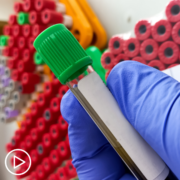How Has Lung Cancer Molecular Testing Evolved?
How Has Lung Cancer Molecular Testing Evolved? from Patient Empowerment Network on Vimeo.
What are the latest advances in lung cancer testing? Dr. Thomas Marron discusses the role of molecular testing when choosing therapy and how innovations in technology have revolutionized lung cancer care.
Dr. Thomas Marron is Director of the Early Phase Trials Unit at the Tisch Cancer Institute at Mount Sinai Hospital. Dr. Marron is also Professor of Medicine and Professor of Immunology and Immunotherapy at the Icahn School of Medicine at Mount Sinai. Learn more about Dr. Marron.
See More from EVOLVE Lung Cancer
Related Resources
Transcript:
Katherine Banwell:
What should patients understand about the results of molecular testing?
Dr. Thomas Marron:
So, molecular testing is extremely important and anybody who has metastatic non-small cell lung cancer should get it. And increasingly, with the new drug approvals, even patients that have earlier stage disease, stage II and III disease should also get molecular testing. Molecular testing is important to identify if there is a potential therapeutic target.
But it’s also important to know that it may predict a response to a therapy, whether that be a targeted therapy or something like immunotherapy. But there is no guarantee. So, there’s no specific result from a molecular test that tells you there’s 100 percent chance you’re going to be cured by Drug X.
And so, it’s important to always know that we’re following the data and we’re giving patients the drugs that, based on the knowledge we have today is the best option for them, based on their molecular test. But it isn’t a guarantee. And sometimes these drugs will work transiently.
And so, they may work for weeks, months, year but then they might stop working. And it’s also important to understand that the mutational profile may change over time, which is one of the reasons why we do these genetic tests. Oftentimes multiple times. Not just at the time of diagnosis, but also when patients’ cancer starts to grow so that we can see if there’s a new molecular target that we might be able to identify and treat with a novel therapy.
Katherine Banwell:
Dr. Marron, are there innovations in technology that are aiding in the advancement of lung cancer research?
Dr. Thomas Marron:
Yeah, so there’s lots of developments in the molecular tests that we’re doing. One of them is that we’re able to track circulating tumor DNA. So, as cancer is growing, it grows in this very unorganized aberrant way, because the on and off growth switches within the cancer, within the DNA are very dysregulated. And what happens is that often times, they’re releasing a lot of cancer cells as they’re growing or also dying and releasing their DNA into the blood.
And so, through blood tests, we’re now able to identify the mutations in a patient’s cancer. And this is a real revolution in the initial diagnosis of metastatic lung cancer because in the past, we had to wait for three, four, five weeks in order to know whether a patient had a targetable mutation like an EGFR mutation. Or if we should use a more agnostic approach, immunotherapy or chemotherapy to treat the patient.
But now when I see a patient, typically I see lung cancer patients on Fridays, I will take some of their blood, I send it off for the liquid biopsy analysis. And by that following Friday, so just one week later, I typically have an answer of if the patient has a mutation that I can target, let’s say with an oral medicine or if they’re a patient that I should be treating with immunotherapy. Additionally, circulating tumor DNA, increasingly we can use it to identify or track a patient’s progress, as far as response to therapy.
And so, this has really been developed in other tumor types, but increasingly we’re using it in lung cancer where we can either track how much cancer they have in their body. So, very early on, we can see if the cancer is shrinking or growing. And additionally, we can use it to detect patients after surgery, whether or not they have residual disease in their body.
And so, a lot of the times patients will undergo surgery because let’s say on a CAT scan, you might only see one large, isolated tumor. But after we take that tumor out, now we can do a blood test to see if there might be microscopic bits of that cancer that were left over, that we weren’t able to see on a CAT scan or PET scan.
And it’s that patient population that we think benefits most from either chemotherapy or targeted therapy after surgery. So, we’re using circulating tumor DNA, both in the metastatic setting, where cancer has already spread to other parts of the body. And also, in the perioperative setting, around the time of surgery or radiation where we’re trying to cure patients. And we’re now able to use this technology to hopefully increase the likelihood that we’re curing them.













